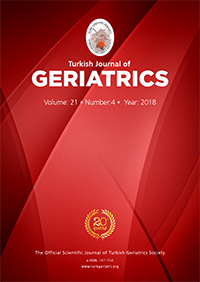2Ankara Ulus State Hospital, Palliative Care, Anesthesiology and Reanimation, Ankara, Turkey DOI : 10.31086/tjgeri.2018.55 Introduction: Palliative care aims to improve quality of care by providing symptom control among geriatric patients; therefore, infection control is of utmost importance as complications increase symptom burden, thus decreasing quality of life.
Materials and Method: Medical records of patients aged ?65 years hospitalized at the palliative care center were retrospectively reviewed. Data on age, sex, diagnosis, comorbidities, length of stay, discharge status and cultures were collected.
Results: Mean age of 305 patients was 80.4±7.1 years and length of stay was 31.1±38.1 days. In total, 131 patients died, whereas 74 were referred to the intensive care unit, and 100 were discharged home. Main comorbidities included cerebrovascular diseases (37.4%), cancer (31.8%), hypertension (40%) and diabetes mellitus (21.3%) in patients who had dementia and Parkinson"s disease. The highest growth was observed in urinary culture (67.9%), followed by blood, wound with the least growth in the tracheal aspirate (8.2%). E.coli was most commonly isolated in urinary, wound and tracheal aspirate culture, whereas Methicillin-Resistant Coagulase Negative Staphylococ was more in blood culture. While wound culture growth was less common in cancer patients, it was significantly more common in patients with Parkinson"s disease, diabetes, and pressure ulcer (p<0.05). Growth in the tracheal aspirate was also significantly more common in patients with hypoxic brain, percutaneous endoscopic gastrostomy, and tracheostomy (p<0.05).
Conclusion: Among patients receiving inpatient palliative care, bacterial growth was most common in urinary cultures, whereas it was higher in the tracheal aspirates of patients with diabetes, tracheostomy, and percutaneous endoscopic gastrostomy.
Keywords : Palliative care; Geriatrics; Infections
